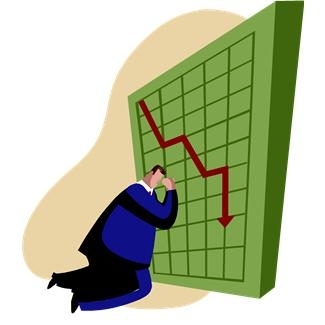| Home | About | Archives | RSS Feed |

@theMarket: Where Is the Bottom?
 Everyone seems to be looking for the same thing, an end to the pain, an end to the stress, a place where the selling stops. It's called a bottom and it appears to me that we haven't found one yet.
Everyone seems to be looking for the same thing, an end to the pain, an end to the stress, a place where the selling stops. It's called a bottom and it appears to me that we haven't found one yet.
One contrary indicator is the sheer number of bottom fishers who are trying to outguess each other on how low the markets can go. Normally bottoms are reached when no one wants to buy and everyone believes the markets are never, ever coming back. So far, I have seen no evidence that investors are in that state of mind.
This has been a waterfall decline and as such, one can look back through history and see how markets have reacted to past selloffs of this type. If you haven't read my Aug. 11 column, "What To Expect From After a Waterfall Decline" please be sure to read it.
Over the last two weeks, the market declined to about 1,100 on the S&P 500 Index and then proceeded to bounce 9.5 percent to about 1,204. Many think that was the bottom. But was it? I looked at some historical data on past waterfall declines, compliments of Ned Davis Research, a highly respected financial firm, hoping to confirm or deny that supposition.
I found that in 8 of 11 post-waterfall decline cases since 1929, the market has made lower lows. So far this decline has been a textbook waterfall decline. They all begin with a breath-taking whoosh downward, find an interim bottom, (in this case S&P 1,100) and proceed to bounce about 10 percent to an interim peak. Our rally this week to 1,204 was about 9.5 percent and would certainly seem to qualify as an interim peak.
Eventually this interim peak is followed by a decline to the final bottom, which in past declines have averaged about 14 percent to 16 percent. That would put the S&P 500 Index at around 1,020. But that is an average decline. If you look at waterfall declines that were caused by debt-related fears such as in 2008, 1940, 1937, 1938 and 1929, then, the bottoms were a good 10-15 percent lower than the average.
Now that does not mean that this decline must replicate past performances. And remember, too, that this type of bottom occurred in 73 percent of the cases since 1929. Therefore, 2011 could turn out differently. My intention is neither to frighten readers nor to call the bottom but rather to give you an idea of what has happened in the past and give you a framework for future risk/reward. At the very least, I would think that there is sufficient historical data to reframe from jumping into the market again at some arbitrary number whether it be 1,100, 1,075 or 1,020.
Bottoms are rarely V-shaped. There is usually a basing period of several months where the markets trade up and down, testing the lows until a sufficient amount of evidence convinces investors to get back in the market. The sectors that perform the best in a basing/testing period are health care, energy, consumer staples, telecom and utilities. Once the market bottom is in, then the sectors with higher betas such as technology, consumer discretionary, financials and industrials outperform.
Bill Schmick is an independent investor with Berkshire Money Management. (See "About" for more information.) None of the information presented in any of these articles is intended to be and should not be construed as an endorsement of BMM or a solicitation to become a client of BMM. The reader should not assume that any strategies, or specific investments discussed are employed, bought, sold or held by BMM. Direct your inquiries to Bill at (toll free) or e-mail him at wschmick@fairpoint.net . Visit www.afewdollarsmore.com for more of Bill's insights.
| Tags: decline, waterfall, bottom, history |

